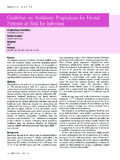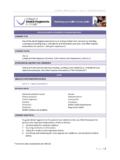Transcription of Adopted by NZDA Board March 2003 CODE OF …
1 Adopted by nzda Board March 2003 code OF PRACTICE ANTIBIOTIC prophylaxis FOR dental TREATMENT OF PATIENTS WITH PROSTHETIC JOINT REPLACEMENTS 1. INTRODUCTION Prosthetic replacement of large joints such as the hip, knee, elbow and shoulder is an increasingly common and highly successful orthopaedic surgical procedure. Haematogenous infection of a prosthetic joint replacement is a devastating complication that can lead to loss of the prosthetic joint and serious morbidity for the patient (Tong and Rothwell 2000). The possibility of oral organisms from bacteraemia infecting a prosthetic joint has encouraged some dentists and orthopaedic surgeons to recommend antibiotic prophylaxis for all patients with prosthetic joint replacement when undergoing dental treatment.
2 However, comprehensive reviews of the literature (Thyne and Ferguson 1991, ADA/AAOS 1997, Tong and Rothwell 2000) have concluded that there is minimal evidence of haematogenous infection of prosthetic joints by oral organisms, the reported range being - The overall risk of haematogenous infection from any source is variously reported as - (Ainscow and Denham 1984, Jacobson and Matthews 1987). The risk of blood-borne prosthetic joint infection must then be compared with the risk of antibiotic prophylaxis . The relative risk of complications, such as allergy from antibiotics, suggests that these complications outweigh the risk of haematogenous prosthetic joint infection by oral organisms.
3 For example, the incidence of acute anaphylaxis to penicillin group antibiotics is reported as - (Tong and Rothwell 2000, Mandell, Bennett and Dolin 2000, Holgate 1988). Despite the low risk of blood-borne prosthetic joint infection of artificial joints by oral organisms, some medical and dental practitioners maintain that so serious are the consequences of prosthetic joint infection that antibiotic cover should be provided in any circumstance likely to produce bacteraemia of oral organisms. It is acknowledged that some patients may be at increased risk of haematogenously spread infection of the prosthetic joint (Thyne and Ferguson 1991, ADA/AAOS 1997, Tong and Rothwell 2000).
4 Patients at potentially increased risk are listed in Table 1 Table 1 Patients with the following medical conditions are at potentially increased risk of haematogenously spread late prosthetic joint replacement infection Inflammatory arthropathies eg rheumatoid arthritis, SLE Immunocompromised and immunosuppressed Diabetes mellitus Steroid replacement therapy Malnourishment Haemophilia Previously infected prosthetic joints Prosthetic joint replacement surgery within the past 2 years 2. ORAL SEPSIS The incidence and magnitude of bacteraemia of oral origin is directly proportional to the degree of oral and gingival inflammation, the concentration of microorganisms in the area, and the degree of tissue trauma (Everett and Hirschmann 1977, Bender, Naidorf and Garvey 1984, Guntheroth 1984).
5 To reduce this bacteraemic risk, patients should have a dental assessment prior to joint replacement, and receive ongoing dental care thereafter. This applies particularly to those patients listed in Table 1. 3. ANTIBIOTIC prophylaxis The low risk of haematogenous prosthetic joint infection from oral organisms, the absence of compelling data for an association between dental procedures and prosthetic joint infection, and the risk of antibiotic associated complications all argue strongly against the routine use of antibiotics before dental procedures, even those procedures generally considered to be associated with an increased incidence of bacteraemia (Bender, Naidorf and Garvey 1984).
6 Notwithstanding these data, the 1997 combined advisory statement from the American Academy of Orthopaedic Surgeons and the American dental Association recommends that patients at potentially increased risk of haematogenous prosthetic joint infection (Table 1) should have antibiotic prophylaxis before dental procedures likely to cause bacteraemia. This is not the universal view, and many would argue that the available data do not support the combined Association's recommendation. It is not in our view "standard of care" to provide antibiotic prophylaxis even for those patients.
7 Nevertheless, for those clinicians who do favour antibiotic prophylaxis , it is important appropriate antibiotics are used. The antibiotic chosen to provide prophylaxis must be active against viridans streptococci in particular, as they are the only oral organisms that would be expected to be assoiated with a dental procedure-induced haematogenous prosthetic joint infection. Ellis-Pegler et al (1999) have produced guidelines for the prevention of infective endocarditis associated with dental treatment. These recommendations: list the dental procedures that are associated with a bacteraemia of sufficient magnitude to justify antibiotic prophylaxis (Table 2)
8 Emphasise the need to maintain good oral health to reduce the incidence and magnitude of orally induced bacteraemia provide recommendations for appropriate antibacterial regimens for prophylaxis against the most commonly occurring microorganisms spread from the oral cavity Table 2 dental procedures creating a bacteraemia of sufficient magnitude to justify antibiotic prophylaxis In general, any procedure that causes bleeding from the gingiva, mucosa or bone Periodontal procedures including probing, scaling, root planing and surgery Endodontic instrumentation or surgery beyond the apex Application of matrix bands below the gingival margin Subgingival placement of gingival retraction cords/strips Placement of orthodontic bands.
9 But not brackets Intraligamentary local anaesthetic injections Reimplantation of avulsed teeth and repositioning of teeth after trauma Oral surgical procedures including biopsy procedures and raising of mucosal flaps Surgical drainage of dental abscesses Extraction of teeth Patients with a potentially increased risk of haematogenous prosthetic joint replacement infection who undergo a dental procedure with significant risk of bacteraemia, and for whom antibiotic cover is deemed appropriate, should receive the antibiotic cover regimen for a patient with moderate cardiac risk as recommended by Ellis-Pegler et al (1999).
10 (Table 3) Table 3 Antibacterial recommendations for dentally-induced bacteraemia in patients who are at potentially increased risk of haematogenously spread late prosthetic joint replacement infection. Standard Oral amoxycillin one hour before procedure and oral amoxycillin six hours later Penicillin allergy Oral cefuroxime axetil one hour before procedure and oral cefuroxime axetil six hours later Oral clindamycin 300mg one hour before procedure and oral clindamycin 150mg six hours later Oral clarithromycin 500mg one hour before procedure.



